#faux tortoise shell
Explore tagged Tumblr posts
Text


Beaverton, OR
#antique combs#vintage combs#Victorian era#tortoise shell#tortoise shell combs#celluloid#celluloid combs#Bakelite#Bakelite combs#vintage Bakelite#antique fashion#antique French combs#faux tortoise shell#tortoiseshell#vintage aesthetic#antique aesthetic#antique accessories#antique beauty#early 20th century#early 1900s#victorian fashion#victorian style#combs#hair comb#estate sale
12 notes
·
View notes
Text
had a very interesting day out where I saved a hypothetical dog's life, aesthetically read in the park, and got in the middle of Strangers Arguing in my temporary new job as Patron Saint of Slackliners
first of all, gorgeous day, low 60s, bright blue sky, warm in the sun but with a refreshingly cool breeze, the trees finally have leaves again, peak Late Spring moment
I stopped at the farmer's market and didn't end up buying anything, but someone at a booth gave me a little sprig of lavender (this is a surprise tool that will help us later!)
passed by a guy squatting on the sidewalk picking up the entire contents of a dropped container of grapes, right as his friend was like "it's fine, just leave it, some dog will come by and take care of it" and I whipped around and went "GRAPES ARE SUPER TOXIC TO DOGS!!!" this is an urban area, people don't have yards, there are So Many dogs on the sidewalks, so my first task set by the universe today was sharing Dog Facts so that none of them die
I arrive at the park. I find a lovely tree to sit under. it is the most vibrantly blue-and-green day imaginable. I have my travel mug of hot tea that is only getting hotter sitting in direct sunlight. I have a sprig of lavender in my pocket. I am wearing—this is important scene setting information—high waisted secondhand wool trousers that definitely once belonged to an old man, a button down, tortoise shell glasses, and (again) a sprig of lavender. I am reading a book of oscar wilde plays. I am a parody of myself, but it's fine because I'm having a great time
and then—The Slackline Drama Begins. two people show up and start setting up a slackline near me and these other two girls who're sitting on the grass. the two girls are in the trajectory of the slackline, so the slackliners ask if they could scoot back a couple feet (or maybe they didn't even, the grass girls were like a little off to the side, so they might've just taken issue with the slacklining happening right next to them—not sure, I hadn't fully clocked into the drama yet)
in either case, the girls refuse to move and take issue with the slackliners, who explain that they're really sorry but they need a certain distance between trees and this is one of the few spots that's good for them to set up. the grass girls are like "well then maybe you should have gotten here earlier :))))))))"
important context: this park is 500 acres. it is not a small park. there is no shortage of grass to sit on. I have gotten lost in this park multiple times. it's vast.
there is a lot of back-and-forth between the slackliners and the grass girls. the one slackliner is getting very upset and angry that the grass girls won't just scoot. slackline girl has been having a rough time and hasn't been able to get outside recently and this is very clearly the final shitty-thing straw. the grass girls are immune to this and using that like...... faux-nice "girl who bullied you in middle school" Meanly Chirpy voice to keep being like "well we were here first so this is Our Spot :))))))) you can't ask people to move in public :)))))"
it has gone on long enough that's impossible to ignore, but my mental math says that jumping in and trying to mediate won't go over well, so instead I just look at upset slackline girl and say—loudly—"I'm on your side." bc I felt like if grass girls with their Faux Polite Tones knew other people were paying attention and were siding with Swearing Slackliner, that would help more
Grass Girls do, finally, get up and leave entirely (instead of just...... scooting over five feet) and they make some snide parting remarks. slackline girl calls them assholes, I loudly agree. Slackline Girl is now sobbing, her friend is comforting her, it's kinda clear she's not gonna be able to have a good time even with grass girls leaving
I go over and I'm like "hey I know you don't know me, but do you want a hug?" and the girl says yes, clings onto me crying, she's being very apologetic about the whole thing and trying to explain, and I'm like "no they were literally just sitting on the grass and there is...... So Much Grass. you are not the asshole. there's so much other grass!" I keep this up with her and the friend until she stops crying, bc like sometimes you do need an outside perspective
I go "hey.......... do you want a sprig of lavender?" and she very tearfully nods and goes "I love lavender"
again, I AM DRESSED LIKE A SNAZZY GRANDFATHER, joining this beef between strangers and doling out random sprigs of lavender
anyway, she's cheering up, so I go back to reading, they get slacklining, they end up needing to tie a line to my tree I'm reading under, I don't have a problem with this because I'm not a dick and we can share the tree, the afternoon passes, eventually it's getting a little chilly so I decide to leave and I'm thinking "okay how can I quickly grab their attention to say goodbye"
but the SECOND they see me stand up and grab my things, they're like BYE THANK YOU SO MUCH!!!!!!! and I'm like "I hope you have a good day!" and she's like "you kinda saved it" I'm full of gooey feelings about it, I genuinely want good things to happen for this person so much, and I'm glad the universe appointed me and my sprig of lavender as her cheerer-upper
in conclusion: I'm enjoying Lady Windermere's Fan so far
19 notes
·
View notes
Text
DIY Tree Branch Buttons & Vinegar Wood Stains

Project by Matthew Robinson:
A few weeks ago, I had the pleasure of showing my friend Matthew Robinson’s art as part of our Sketchbook Sneak Peek series. In addition to being a wildly talented painter and art teacher, though, Matt is also enviably adept at all manner of hands-on skills, from carpentry to crafting. Last winter, while he and his girlfriend Romina were visiting our apartment, I happened to notice his unusual shirt buttons. They were crafted, not from plastic or faux tortoise shell, but from wood. Cross-sections of tree branch wood, to be more exact. Ever since then, I’ve been dying to have him show me how to create such adorable, practical notions. Last week, he finally obliged and it turns out that the project is as easy as it is beautiful. Check out Matt’s full tutorial (and tips for making your own natural wood stains) after the jump! —Max
Materials
1 tree branch, the diameter of which should be about the size you’d like to make your buttons
A coping saw
1 clamp
A power drill
Some scrap wood
Sandpaper
A paint brush
Vinegar
Rusty nails or pennies
Shellac (Matt used Zinsser’s Bullseye Shellac)
A shirt and some thread!
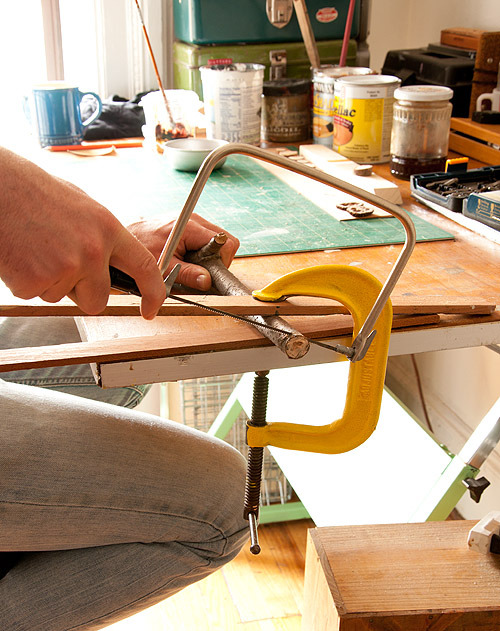
Directions
1) Place your tree branch on a work surface and clamp it so that part of it comes out over your surface’s edge.
2) Using your coping saw, cut a thin slice from your branch.

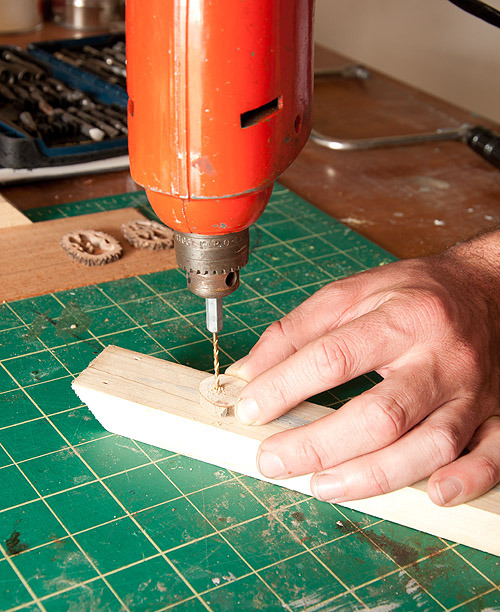
3) With a power drill with a small drill attachment, drill two holes into your branch slice. Be sure to place some scrap wood underneath while you drill, to avoid putting holes into your work surface!

4) Rub your button against some sand paper to smooth out its surface.
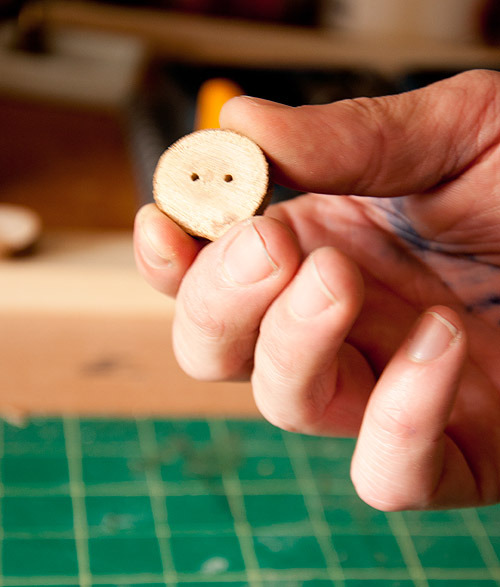
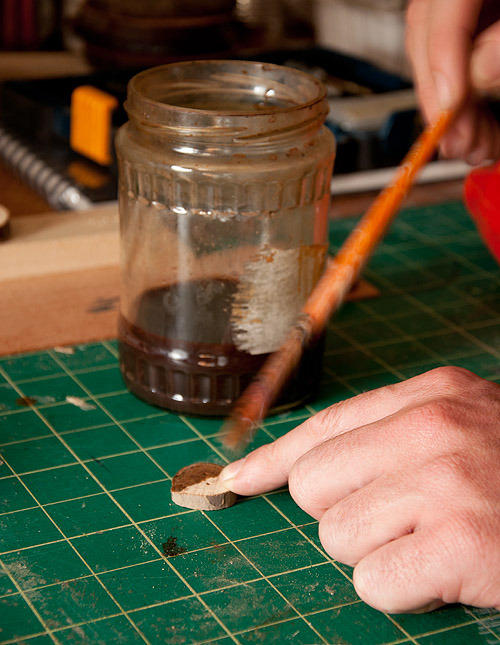
5) If you desire, brush on a coat of wood stain, followed by a coat of shellac. The shellac will seal the wood, allowing it to survive multiple machine washes.
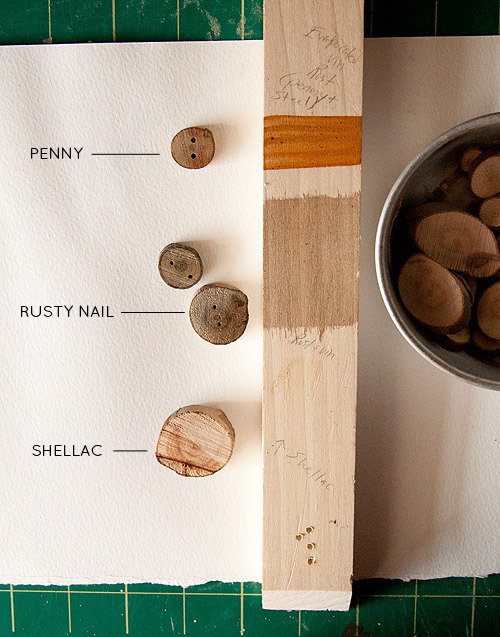
Above: Matt created natural wood stains by soaking pieces of scrap metal (from pennies to rusty nails) in jars filled with vinegar. The vinegar and metal chemically react to create a beautiful, natural wood stain that can be brushed on. As you can see, different metals create different colored stains. While pennies create a warmer tone, rusty nails create a more somber, gray look. Experiment with different metals to see what you like best!
6) Allow your buttons to fully dry and then sew them onto your clothes! Presto! Beautiful, handmade buttons for fall!
6 notes
·
View notes
Photo
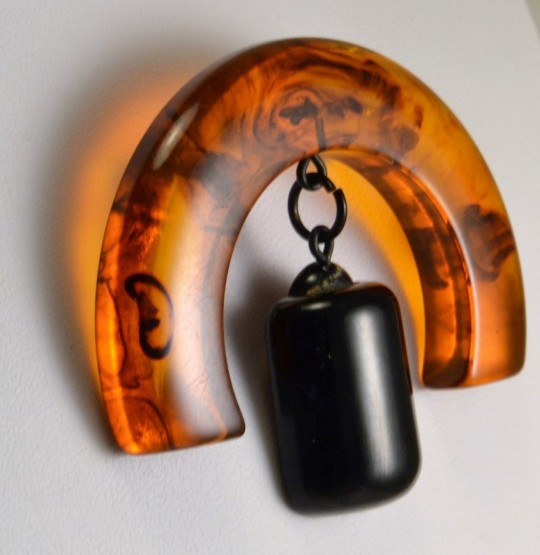
https://www.etsy.com/listing/1032926889/modernist-brooch-scarf-pin-lucite-faux
This Modernist brooch is a beauty! A 3D semicircle has a Tortoise Shell pattern. From it's center dangles a black 1/2 cylinder.
2 notes
·
View notes
Link
Check out this listing I just added to my Poshmark closet: FALL BLING Necklace Multi Strand.
0 notes
Link
Check out this listing I just added to my Poshmark closet: NOBO Juniors Ribbed Top.
0 notes
Text


Mid-Century Modern MCM Faux Tortoise Shell Cosmetic Makeup Box Case vintage - sold.
1 note
·
View note
Link
Check out this listing I just added to my Poshmark closet: Lauren Ralph Lauren Fashion Necklace Bracelet Set with Dust bags & Box NWT.
0 notes
Link
Check out this listing I just added to my Poshmark closet: Relic Purse with Faux Tortoise Shell Handles.
0 notes
Link
Check out this listing I just added to my Poshmark closet: CAbi Sunday Topper Velvet Collared Jacket Style 3377 Size Medium.
0 notes
Text
Calligraphy History Overview: Tracing the Origins

Calligraphy History Overview: Ancient Beginnings and Global Spread
Discover the captivating journey of calligraphy through the ages. From its ancient origins to its modern-day revival, this art form has left an indelible mark on cultures around the world. Join us as we explore the origins of calligraphy, its influence on different civilizations, and its continued relevance in the digital age. Throughout history, calligraphy has been a visual expression of human creativity and communication. Let's delve into the rich tapestry of calligraphy, starting with its ancient beginnings. Key Takeaways: - Calligraphy has a diverse history, originating from various civilizations such as ancient China, Egypt, and Rome. - Chinese calligraphy played a significant role in influencing other Asian cultures, including Japan and Korea. - Western calligraphy developed alongside the use of the Latin alphabet and became closely tied to religious texts. - Modern calligraphy embraces individuality, breaking free from traditional rules and exploring new techniques like faux calligraphy and hand lettering. - Calligraphy requires specific tools and materials, such as ink brushes and smooth writing surfaces, to achieve desired results.
Ancient Calligraphy Origins: The Beginnings of Beautiful Writing

Calligraphy, the art of beautiful writing, has its origins in ancient civilizations. Let's take a closer look at the early development of calligraphy, starting with some of the earliest forms of written communication. In ancient China, calligraphy began with the carving of characters on bones and tortoise shells. Over time, these characters evolved into the intricate strokes and brushwork that we associate with Chinese calligraphy today. Similarly, in Egypt, hieroglyphics were meticulously painted and used to convey both words and images. The ancient Aramaic and Hebrew book hands also showed significant calligraphic qualities. The Romans, known for their advancements in many fields, also made their mark on calligraphy. They used reed or quill pens to write on long rolls of paper, and their calligraphy can be seen in monumental inscriptions and on manuscripts. Greek hands on papyrus scrolls also displayed calligraphic elements. Ancient Calligraphy Origins: Key Points - Calligraphy's origins can be traced back to ancient civilizations such as China, Egypt, and Rome. - Chinese calligraphy started with characters carved on bones and tortoise shells. - Egyptian hieroglyphics and ancient Aramaic and Hebrew book hands also exhibited calligraphic qualities. - Romans used reed or quill pens to write on long rolls of paper, and Greek hands on papyrus scrolls featured calligraphic elements. Table: Ancient Calligraphy Origins Civilization Form of Calligraphy Ancient China Characters carved on bones and tortoise shells Egypt Meticulously painted hieroglyphics Ancient Aramaic and Hebrew Book hands with calligraphic qualities Rome Reed or quill pen calligraphy on paper Greece Calligraphic elements in hands written on papyrus scrolls
Chinese Calligraphy Influence: The Spread of the Art Form
Chinese calligraphy has had a profound influence on the development of calligraphy in neighboring cultures such as Japan and Korea. The art form's influence can be observed in various aspects, including the use of Chinese ink brushes and writing on silk. Japanese calligraphy, known as "shodo," was heavily influenced by Chinese calligraphy. The Japanese adopted Chinese characters and writing techniques, incorporating them into their own unique styles. The emphasis on brushwork and the aesthetic principles of simplicity and elegance are hallmarks of both Chinese and Japanese calligraphy. Korean calligraphy, or "seoye," also draws inspiration from Chinese calligraphy. Korean calligraphers developed their own distinct scripts and styles while maintaining the fundamental principles of Chinese calligraphy. The influence of Chinese calligraphy can be seen in the use of brush and ink, as well as the importance placed on balance and harmony in the composition of characters. Chinese Calligraphy Influence Japanese Calligraphy Korean Calligraphy Use of Chinese ink brushes Adoption of Chinese characters and writing techniques Development of unique scripts and styles Writing on silk Emphasis on brushwork and aesthetic principles Importance placed on balance and harmony The influence of Chinese calligraphy extends beyond Japan and Korea, reaching other cultures as well. Chinese calligraphy has inspired artists and calligraphers around the world, who have incorporated elements of Chinese calligraphy into their own artistic practices. The exchange of calligraphic traditions has enriched the art form and contributed to its evolution, demonstrating the enduring impact of Chinese calligraphy on the global stage.
Western Calligraphy History: The Role of Latin Script

Western calligraphy has a rich history that centers around the use of the Latin alphabet. The development of calligraphy in the Western world can be traced back to the ancient Romans. They wrote using reed or quill pens on long rolls of paper, creating elegant and precise script known as Roman calligraphy. Calligraphy in Western societies also played an essential role in the Christian faith. Monks and scribes used calligraphy to copy and preserve sacred texts, such as the Bible. These intricate manuscripts, adorned with beautifully calligraphed letters, showcased the reverence and devotion of the Christian community. The Christian use of calligraphy further popularized the art form and elevated its status. Over time, calligraphy in the Western world saw advancements in writing instruments. Steel nibs replaced feather quills, providing more durability and ease of use. This innovation led to the development of Copperplate calligraphy, where calligraphic strokes were engraved on metal plates for printing purposes. The introduction of steel nibs and Copperplate calligraphy contributed to the widespread adoption and practice of calligraphy in Europe and beyond. Through the influence of the Latin script, Western calligraphy has become an integral part of art, literature, and religious practices. Its evolution and adaptation over the centuries showcase the enduring beauty and significance of calligraphy in Western culture. Table: Comparison of Western Calligraphy Styles Calligraphy Style Description Roman Calligraphy The oldest form of Western calligraphy, characterized by its use of reed or quill pens and long, flowing strokes. Carolingian Calligraphy A style developed during the reign of Charlemagne, known for its clear and legible script. Gothic Calligraphy A decorative and elaborate script commonly used in medieval Europe for religious texts and manuscripts. Copperplate Calligraphy A style developed in the 18th century, characterized by its engraved calligraphic strokes and elegant flourishes. Modern Calligraphy A contemporary style that blends traditional calligraphy techniques with a more freeform and expressive approach. Quote: "The art of calligraphy in the Western world has been shaped by the use of the Latin alphabet and its role in religious practices. From the meticulous script of Roman calligraphy to the decorative flourishes of Copperplate, Western calligraphy showcases the beauty and precision of the written word."
Modern Calligraphy: Breaking the Rules and Embracing Individuality

Modern calligraphy offers a departure from the strict traditional rules of the art form, allowing for greater freedom and individual expression. While traditional calligraphy adheres to specific guidelines and techniques, modern calligraphy encourages artists to explore variations and experiment with new styles. One popular trend in modern calligraphy is faux calligraphy, which uses techniques to imitate the appearance of traditional calligraphy without the need for specialized tools or extensive training. With faux calligraphy, anyone can create beautiful lettering by simply adding thickness to the downstrokes of their handwriting. This accessible approach to calligraphy has made it a favorite among beginners and casual enthusiasts. Another contemporary style gaining popularity is hand lettering, which blends calligraphy with illustration. Hand lettering allows artists to combine beautiful letterforms with intricate designs, creating visually stunning compositions. It is a versatile style that can be used in various applications, such as greeting cards, signage, and branding. Brush lettering is another modern calligraphy style that utilizes brush pens to achieve fluid and expressive letterforms. The flexible bristles of the brush pen allow for a wide range of strokes, from thick to thin, resulting in dynamic and visually captivating lettering. Brush lettering is often used in artistic projects, such as posters, artworks, and decorative designs. Modern calligraphy embraces the idea that there are no strict rules in art, allowing artists to push boundaries and discover their own unique style. Whether through faux calligraphy, hand lettering, or brush lettering, modern calligraphy provides a platform for self-expression and creativity, making it an exciting and evolving art form in the digital age. The Evolution of Calligraphy Styles The shift towards modern calligraphy reflects the changing times and evolving tastes of artists and enthusiasts. While traditional calligraphy styles continue to be revered and practiced, the emergence of modern calligraphy has opened up new possibilities and expanded the boundaries of the art form. Traditional Calligraphy Modern Calligraphy Strict adherence to traditional rules Emphasis on individuality and creativity Focus on technique and precision Exploration of variations and experimentation Limited accessibility and exclusivity Wide accessibility and inclusivity Preservation of historical styles and traditions Integration of contemporary influences and trends "Modern calligraphy allows for personal expression and provides a platform for artists to experiment and innovate. It breaks away from the rigidity of traditional calligraphy, encouraging individuals to explore their own unique style and find their creative voice." - Calligraphy enthusiast With its emphasis on individuality and creativity, modern calligraphy has gained a strong following and continues to inspire artists around the world. As the art form evolves, it will be fascinating to witness the new and innovative styles that emerge, pushing the boundaries of calligraphy and keeping the tradition alive while embracing the spirit of contemporary expression.
The Significance of Calligraphy Tools and Materials

Tools and materials are essential to the practice of calligraphy, as they play a crucial role in achieving desired outcomes and maintaining the integrity of the art form. From writing surfaces to quill pens and ink brushes, each element contributes to the precision and beauty of calligraphic works. The writing surface acts as a foundation for calligraphy, providing a smooth and receptive medium for ink. Paper, parchment, and silk are commonly used surfaces that allow for precise strokes and controlled ink flow. The choice of writing material depends on the desired effect and the specific calligraphic style being pursued. "The tools of the trade can greatly influence the outcome of a calligraphic work. The choice of pen or brush, the quality of the ink, and the type of writing surface all contribute to the overall aesthetic and execution of the piece." - Calligraphy Master Quill pens and ink brushes are the primary instruments used in calligraphy. Quill pens, traditionally made from the feathers of birds such as geese or swans, allow for precise control of the ink flow and the creation of delicate, thin lines. Ink brushes, on the other hand, offer versatility in stroke width and texture, allowing for a range of expressive possibilities. The importance of tools and materials in calligraphy cannot be understated. They not only facilitate the creation of beautiful letterforms but also enable calligraphers to express their creativity and unique style. The right tools and materials are essential for achieving the desired effects and ensuring the longevity of calligraphic works. Calligraphy Tools Importance Quill Pens Provide precise control and delicate lines Ink Brushes Offer versatility and expressive possibilities Writing Surfaces Smooth and receptive mediums for ink
Calligraphy in Society and Religion: From the Service of God to Individual Expression
https://www.youtube.com/watch?v=IPYfKSBPNHE Calligraphy has played a significant role in both societal and religious contexts throughout history. In Western societies, calligraphy held a religious significance, with calligraphers often being in service to religious institutions. The intricate and meticulous craftsmanship required for calligraphy made it a suitable art form for copying sacred texts and conveying the divine word. In the Far East, calligraphers were recognized as artists in their own right, with their works being highly esteemed and celebrated. Calligraphy in these cultures was not solely limited to religious texts but was also used to depict various aspects of life, literature, and philosophy. Calligraphers in these regions were able to express their individuality through their unique styles and interpretations of the art form. "Calligraphy is not just a means of writing; it is an expression of one's soul and spiritual journey." - Master calligrapher Zhang Zhengyao While historically calligraphy has been male-dominated, women have also made significant contributions to the field. Their talents and dedication have helped shape the art form and have challenged traditional gender roles. Today, the position of the calligrapher in society varies across cultures. In some regions, calligraphers are revered and hold esteemed positions, while in others, the role of the calligrapher may be less understood or valued. Role in Society and Religious Calligraphy Calligraphy not only holds cultural and historical significance but also bridges the gap between the spiritual and the tangible. It has the power to convey meaning beyond words, evoking emotions and capturing the essence of a message. The position of the calligrapher in society reflects the attitude towards calligraphy and its role in preserving cultural and historical heritage. Throughout centuries, calligraphy has served as a medium of communication, a tool for artistic expression, and a method of preserving cultural and religious traditions. Today, calligraphy continues to thrive, with artists exploring new ways to incorporate this ancient art form into contemporary contexts. Role of Calligraphy in Society Religious Calligraphy Individuality in Calligraphy Position of Calligrapher in Society Preserves cultural heritage Expresses devotion and spirituality Allows for personal style and interpretation Varies across cultures Communicates important messages Conveys sacred texts and teachings Encourages artistic exploration Can be highly esteemed or less understood Promotes artistic traditions Embodies the divine word Reflects the calligrapher's personality May challenge traditional gender roles As calligraphy continues to captivate and inspire, its significance in society and religion remains deeply rooted. From the service of God to individual expression, calligraphy has transcended time and cultural boundaries, shaping the way we communicate, express ourselves, and appreciate the beauty of the written word.
The Beauty of Calligraphy: From Writing to Visual Expression
Calligraphy is not just about writing; it is a form of visual expression that transforms words into art. The meticulous strokes and elegant compositions of calligraphy make it a truly beautiful form of writing. Through pictorial expressions and creative arrangements of letters, calligraphy goes beyond its practical purpose and becomes a work of art in its own right. Traditional calligraphy is characterized by its focus on technique and form, but it also incorporates visual execution that adds depth and meaning to the words being written. The placement of each stroke, the balance of negative space, and the overall composition contribute to the visual impact of the calligraphic piece. This attention to detail creates a harmonious and visually captivating result. "Calligraphy is a skill that requires not only mastery of the pen but also an understanding of aesthetics. It is the balance between precision and artistic expression that gives calligraphy its unique beauty." In calligraphy, text pictures and calligrams are created, where the visual representation of the letters enhances the meaning of the text. Text pictures are formed by arranging letters in a way that creates a recognizable image, while calligrams use the form of the letters themselves to depict an object or concept. These creative applications of calligraphy add an expressive and artistic element to the written word. Whether it is the intricate brushstrokes of Chinese calligraphy, the flowing curves of Arabic script, or the precise lines of Roman lettering, calligraphy captivates with its sheer beauty. The fusion of form and meaning in calligraphy makes it a timeless art form that continues to inspire and delight people around the world. Table: Examples of Beautiful Calligraphy Styles Chinese Calligraphy Arabic Calligraphy Western Calligraphy Japanese Calligraphy Korean Calligraphy
The Revival of Calligraphy: A Renewed Interest in the Art Form
Calligraphy, once considered a traditional art form, has experienced a remarkable revival in recent years. With the advent of the digital age, contemporary calligraphy has embraced new possibilities for expression and creativity. Read the full article
#AncientCalligraphyOrigins#CalligraphyCulturalSignificance#ChineseCalligraphyInfluence#ModernCalligraphyTrends#WesternCalligraphyDevelopment
0 notes
Link
Check out this listing I just added to my Poshmark closet: Vintage Trifari Tortoise Shell Turtle Brooch - Faux Lucite Pin - HTF Collectible.
0 notes
Link
Check out this listing I just added to my Poshmark closet: FALL FINERY Faceted Multi-Strand Necklace.
0 notes
Link
Check out this listing I just added to my Poshmark closet: BaubleBar Graduated Chunky Lucite Faux Tortoise Shell Chain Link Necklace NICE.
0 notes
Link
Check out this listing I just added to my Poshmark closet: Schiaparelli VTG Women’s Watch W/Faux Tortoiseshell Band.
0 notes
